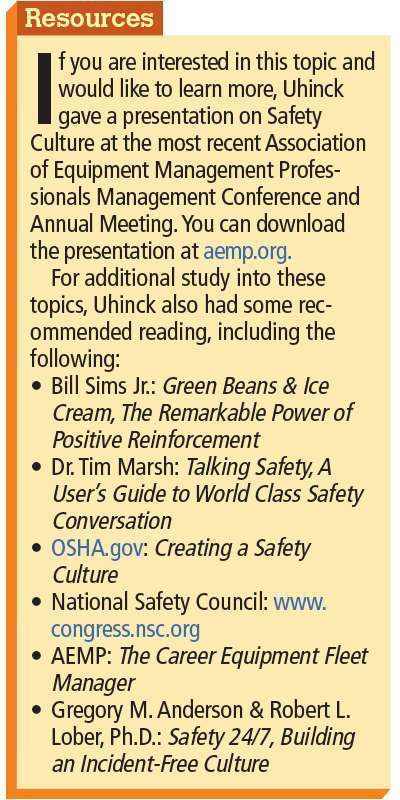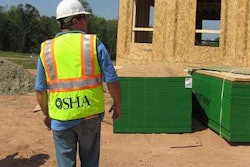
According to Carl Uhinck, asphalt equipment manager at Kokosing, a true safety culture has the following elements:
- Everybody is responsible for safety – 24/7.
- Employees will go above and beyond the normal requirements to identify unsafe conditions or behaviors.
- Everyone has the courage to act and the empowerment to stop unsafe work.
- Everybody gives and receives honest feedback willingly.
- Safety is communicated in every conversation.
- Everyone is committed.
Being a major player in the construction arena, Kokosing has always had a rigorous safety program, but about eight years ago, its top management decided to take it to a whole new level, says Uhinck. “They wanted to drive home the culture of safety and the requirement for personal commitment from each employee to work safe. Upper management passed the message down to the vice presidents, who passed it down to department managers, who took the message to the smaller teams,” he says.
Uhinck recalls a managers’ meeting in which somebody asked how many people at Kokosing work in safety. The correct answer, says Uhinck, is everybody.
Fear of confrontation

Confrontation over safety issues can be uncomfortable. That’s why it’s rarely done.
“It’s absolutely the hardest thing to do,” Uhinck says. “You have to have the courage to approach an employee when you see something unsafe, speak up and have a genuine conversation. It’s huge. It’s been the biggest challenge for me.”
Fear that the conversation is going to end badly causes too many people to look the other way. But if you don’t have the conversation, what does that reveal? “You are saying that the unsafe behavior is OK; that it is acceptable,” Uhinck says. “Don’t think they don’t notice, because they do. They notice when you don’t set the example. Your leadership is defined by the way people act when you’re not around.”
So, how do they handle it at Kokosing? Two key ingredients: a personal safety message, and the power of positive reinforcement.
The personal safety message
Kokosing asks every employee to write out a personal safety message and share it with their co-workers and managers. The message answers one question: Why is safety important to you?
For a lot of guys, it’s family, says Uhinck—being able to go home in one piece everyday and enjoy their family life. But, it doesn’t have to be family. Maybe a guy wants to stay healthy so he can ride his Harley Davidson on weekends, or enjoy his fishing cabin. The reasons vary, but the most important part is that they’re personal and shared with other coworkers.
That personal hook gives everybody a conversational entry point when it comes to confronting unsafe behaviors, Uhinck says. Armed with this knowledge, if you see a guy working without his safety glasses, you can say: “You told us in your personal safety message that you love to watch your grandkids play baseball. If that grinding wheel blows up in your face, it may blind you, and you’ll never see your grandkids play baseball again.”
Uhinck says you follow the personal appeal with open-ended questions, such as: ‘Why do you feel this isn’t going to work? Why is the process you’re doing now better that what we think we should be doing?’ “Making it personal for each employee usually overcomes any pushback, and typically we come to the same conclusion.” Most of the time, those conversations turn out to be much worse in anticipation than they are in reality, he says.
Uhinck admits that some people are more receptive than others. “You have to reach every person, not just the easy ones, and that ties in with the courage aspect,” he says. “If you operate with honesty and integrity, and you have good, honest conversations with people, you’re going to reach them. You just have to have the courage to have that conversation.”
Positive reinforcement
One of the methods that helped Uhinck with these conversations was the power of positive reinforcement. After all, you don’t want your first conversation (or most of your conversations) to be negative or critical.
“For some reason, it’s hard for some age groups to say ‘good job’ to other workers,” Uhinck says. But, at a minimum, you need a seven-to-one ratio of positive to negative comments. As a leader, positive comments should be a part of your daily routine.
“Plan for spontaneous recognition,” Uhinck says. “I plan for mine driving to work everyday, thinking about the things I’ll see that I can give positive recognitions for; things like people using the chock blocks, or wearing their Type 2 safety glasses.” Uhinck also recommends encouraging employees to pay that recognition forward and offer their own ‘atta-boys’ to encourage good safety practices. Doing so makes it much easier for employees to accept the corrections or critical comments that may be needed in the future. And keep in mind, says Uhinck, the old Army adage: praise in public, criticize in private.
It may not seem natural to recognize or reward people in the construction environment, but it must be done if your company is going to achieve a true safety culture with 100 percent buy-in. “Yelling at people won’t stick home,” says Uhinck. “You have to reach peoples’ hearts. And once you reach their hearts, you won’t have to stand over them yelling.”
Take the lead
Some companies might believe there’s a big difference between the safety programs in the field and safety in the shop. But in fact, fleet management and maintenance can (and should) play a critical role in supporting safety in the field.
In many cases, the fleet managers, technicians and mechanics know more about the machinery than any other group in the company, Uhinck says. “Each time we buy a new machine, it is our equipment manager’s job to understand the entire scope of what we buy: the specs, updates, processes, new safety devices and the lock-out/tag-out procedures. And it’s our job to disseminate that to the operations group. Often times, our technicians are the lead trainers and spend a lot of time with the operators, reminding them of the safety aspects and functionality of each machine.”













